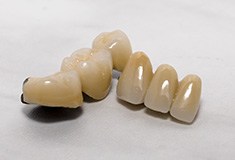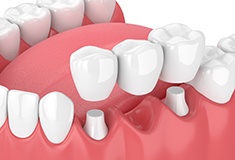
Dental Bridge – Forest, VA
Closing the Gaps in Your Smile

Like millions of other Americans right now, you’re dealing with an ongoing dental problem. You may have a few pearly whites that are either missing or damaged. What do you do? For many patients, the solution is as easy as picking up the phone and calling Crossroads Family Dentistry about a dental bridge in Forest. There, our team can use a specially-designed porcelain restoration to renew your beautiful and healthy smile, often over the course of just two simple appointments. Read on or give us a call today if you wish to learn more!
Support – please reuse the current image for the “What is a dental bridge?” section. Thanks!
What Is a Dental Bridge?

Instead of treating a tooth that is already there, a bridge is used to help bring missing teeth back. For this, two crowns are placed on the teeth on either side of the gap in a patient’s smile, and these are attached to prosthetic teeth (or tooth) to close it. Bridges can be made to be fixed or removable, and they can even be supported by dental implants to deliver a better result.
In any case, our team only works with the finest local dental labs to fabricate your restorations ensuring they are beautiful, natural-looking, and built to last. If you’re tired of dealing with missing teeth, give us a call today, and you’ll have your original smile back before you know it!
Types of Dental Bridges

The first thing you’ll want to do if you’re struggling with tooth loss is to schedule an initial consultation with our team at Crossroads Family Dentistry. By visiting us, we’ll review your dental history and discuss your smile goals to help determine which kind of dental bridge would be best for you.
Traditional Dental Bridge
A traditional bridge consists of two dental crowns that are anchored to two supporting teeth on either side of the gap. This will allow your restoration to rest against your gums for support. This option does require preparing some of your healthy teeth by removing a tiny amount of the enamel. Once the bridge is cemented in place, you’ll be able to fully enjoy your renewed smile.
Implant Bridge
While similar to traditional dental bridges, this option involves surgically embedding metal implants into your jawbone. Not only will this preserve any adjacent natural teeth, but your restoration will also help maintain a more youthful facial structure. On top of that, your dental implants can last several decades to a lifetime with proper care!
The Benefits of Getting a Dental Bridge

Here are several advantages of a dental bridge that makes it one of the most sought-after tooth-replacement options:
- Can rebuild one or multiple missing teeth.
- Maintains the position of your other remaining teeth.
- Makes oral hygiene (brushing, flossing, etc.) easier in the long run.
- Blends seamlessly with the rest of your smile.
- Can last 15+ years with proper care and routine dental visits.
- Can preserve a strong jawbone (if you opt for an implant bridge).
Please reuse the current image from the current “Dental Bridge FAQs” section.
Dental Bridges FAQs
Can You Take a Dental Bridge Out?
No, dental bridges are designed to remain in your mouth for many years after being placed. You shouldn’t be able to take a dental bridge out of your own – only a dental professional can. Some healthcare providers call partial dentures “removable bridges,” but this isn’t entirely accurate. Partials are similar to bridges, but one of the key differences is that partials can be removed by the patient at any time, but dental bridges cannot.
Is Getting a Dental Bridge Painful?
Before your teeth are prepared to support the bridge, your mouth will be numbed by a local anesthetic, so you shouldn’t feel a thing. After the preparation and placement of your dental bridge, the underlying teeth will likely feel sensitive for a few days. This can be managed with over-the-counter pain relievers. If discomfort persists or worsens, give us a call. Because dental bridges keep your remaining teeth from shifting out of place, they are able to prevent discomfort later on.
How Many Teeth Can a Dental Bridge Replace?
Depending on the needs of the patient, a dental bridge can replace anywhere from one to four missing teeth in a row. In most cases, bridges are used to replace just one or two teeth. The longer the bridge extends, the less stable it becomes, especially if the natural teeth supporting the bridge aren’t strong and healthy. Ultimately, it becomes riskier to replace three or more teeth with a dental bridge. Implant bridges can lower this risk, as implants are just as strong and secure as natural teeth.
Do Dental Bridges Feel Natural?
Within just a few days of receiving your permanent dental bridge, it should start to feel increasingly natural. Bridges are made from durable materials that can stand up to everyday chewing forces just as easily as tooth enamel, so eating with a bridge shouldn’t feel strange. Each bridge is customized based on impressions taken of the tooth, so it shouldn’t feel awkward or even noticeable.
Can Dental Bridges Get Cavities?
It is impossible for dental bridges themselves to develop cavities. However, the natural teeth underneath it still can. Food debris can become trapped beneath the pontics or in the space where the crowns meet the gums, attracting harmful bacteria that may result in cavities or even gum infections. This is more likely to occur with poor oral hygiene, which is why it’s essential to clean under and around your bridge every day.
Are Dental Bridges Cheaper Than Implants?
Yes. In most cases, dental bridges are less costly than dental implants. However, the cost can vary depending on multiple factors, including the number of teeth that you are missing. Dental implants require oral surgery, so you might have or pay specialist fees for this procedure. You’d also need to pay for the implant posts in addition to your restorations. Dental insurance often partially covers bridges, but they rarely cover dental implants, so bridges tend to be more cost effective. During your consultation with us, we will go over all of your options to determine which one is right for you.
Are Dental Bridges Covered by Insurance?
Yes, but the level of coverage can vary between different providers and plans. Most dental insurance providers consider dental plans consider bridges to be a major procedure, so they typically cover up to 50% after you have met your annual deductible and before you have exceeded your maximum. Other options, like CareCredit and our membership plan, are available to help make your treatment even more affordable.
Is a Partial Denture the Same as a Bridge?
No. Partial dentures are sometimes referred to as “removable bridges,” but they are not the same thing as a traditional bridge. A bridge is designed to stay in place for many years and can only be removed by a dentist, but a patient is able to remove their partial denture at any time. The other main difference is that bridges only replace missing teeth if they are consecutive, but partial dentures can bring back multiple teeth at various points along an arch.